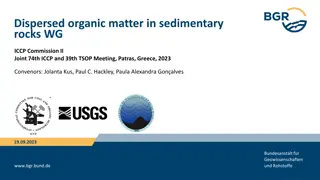
Igneous Rocks and Petrology Concepts
Explore the fascinating world of igneous rocks and petrology, delving into the formation process of magma, crystallization, and solidification. Learn about the classification of igneous rocks based on chemical composition, mineralogy, and grain size. Discover the significance of silica percentage and saturation in distinguishing different types of igneous rocks.
Download Presentation

Please find below an Image/Link to download the presentation.
The content on the website is provided AS IS for your information and personal use only. It may not be sold, licensed, or shared on other websites without obtaining consent from the author. If you encounter any issues during the download, it is possible that the publisher has removed the file from their server.
You are allowed to download the files provided on this website for personal or commercial use, subject to the condition that they are used lawfully. All files are the property of their respective owners.
The content on the website is provided AS IS for your information and personal use only. It may not be sold, licensed, or shared on other websites without obtaining consent from the author.
E N D
Presentation Transcript
Petrology (2)
IGNEOUS ROCKS Igneous rocks (from the Latin word for fire) form when magma (molten rock) crystallizes and solidifies. Magma (from Ancient Greek (magma) meaning "thick unguent or ointment") is a complex mixture of molten or semi-molten silicate rocks with volatiles as gas or fluids, that is found beneath the surface of the Earth. Temperatures of most magmas are in the range 700 C to 1300 C . This confined high-temperature magma rises up toward the surface of the earth to harden by cooling, either very quickly to suddenly reach the surface to give extrusive rocks (also called volcanic rocks) , or solidify this melt in the earth's cavity as it penetrates the Earth's layers slowly to give the intrusive rocks (also called plutonic rocks). The most important factor that a control the speed of magma ascends is viscosity. The higher the magma viscosity, the slower the speed, and vice versa.
CLASSIFICATION OF IGNEOUS ROCKS Most igneous rock classifications are based on one or combination of the following: (1) chemical composition of whole rock, (2) chemical effect on mineralogical composition, (3) mineralogical classification and (4) grain size and occurrence. 1) Chemical Composition of Igneous Rocks or Chemical Classification The great increased availability of chemical analyses of rocks made possibly by rapid and relatively inexpensive instrumental techniques has caused emphasis the chemical classification of igneous rocks. classifications are obvious for very fine-grained rocks, whose mineralogical compositions are obscure. The analyses have been tabulated in order of increasing silica content to see the effect of differentiation in igneous rocks. The analyses include both major oxides (wt%) such as (SiO2, Al2O3, Fe2O3, FeO, MgO, CaO, Na2O, K2O and H2O) and less common elements known as trace elements (ppm) such as (Rb, Ba, Cr, Ni, Sr, Zr and Y). The advantages of chemical
2) Chemical Effect on the Mineral Composition a) Silica percentage Silica is the most abundant oxide and shows the great absolute variation in weight per cent in igneous rocks. Early recognition of this fact let to the broad subdivision of igneous rocks given in Table 1, based upon their silica percentage: Table 1 subdivision of igneous rocks by silica percentage Rock type Silica percentage wt% Example Plutonic Volcanic 1) Acidic rocks > 66% Granite Rhyolite 2) Intermediate rocks 52-66 Syenite Trachyte 3) Basic rocks 45-52 Gabbro Basalt 4) Ultrabasic rocks < 45 Peridotite Kimberlite
b) Silica Saturation It is observed that forsteritic olivine is not found in equilibrium with free quartz whereas a magnesian orthopyroxene coexist with free quartz. Forsteritic olivine can be termed undersaturated with respect to quartz whereas orthopyroxene would be saturated. Again the feldspathoids minerals such as leucite and nepheline are never found with free quartz, whereas orthoclase and albite often occur with free quartz. The two feldspathoids are thus undersaturated and orthoclase and albite are saturated. So the igneous rocks can simply be grouped on the basis of their mineralogy into: (1) Oversaturated rocks: Rocks that contain free quartz; granite is oversaturated rock. (2) Saturated rocks: Rocks that contain neither free quartz or undersaturated minerals: diorite is an example. (3) Undersaturated rocks: Rocks that contain undersaturated minerals: nepheline syenite is an example.
3) Mineralogical classifications Mineralogical classifications are normally based on one or more important variables: a) Presence or absence of quartz, feldspathoids, or olivine. b) Percent and types of feldspars. c) Percent and types of dark minerals (ferromagnesian minerals). Some of these variables are dependent of one or another. For example, an increase in anorthite content of plagioclase generally correlates with an increase in ferromagnesian minerals.
Minerals found in igneous rocks are three types: (1) Essential minerals fall into two classes: a) Specific minerals that are determining the name of the rock, such as quartz, orthoclase and plagioclase in granite. b) Characteristic minerals those that are important enough to indicate the variety of that rock, such as biotite in biotite-granite. (2) Accessory minerals are less abundant minerals such as sphene and magnetite. The above (1) and (2) are primary minerals formed by primary crystallization. (3) Secondary minerals are formed from the alteration of primary minerals after crystallization such as chlorite from biotite.
a) Color index Feldspars, feldspathoids, quartz and muscovite are typically colorless or light in color. They are known as light or felsic minerals. The color of igneous pyroxenes, amphiboles, olivine, biotite and opaque minerals is by contrast dark, and these minerals are known as mafic minerals. They are also known as ferromagnesian minerals as they all contain essential iron and magnesium oxides. The color index is the relative amount of light and dark minerals. To classify igneous rocks based on the color index, igneous rocks are classified into four groups : 1) Leucocratic Rocks : rocks where felsic minerals% is very high. e.g. acidic rocks, granite. 2) Mesocratic Rocks : rocks where % of felsic minerals is almost equal to that of mafic minerals. e.g. intermediate rocks, diorite. 3) Melanocratic Rocks : rocks where % of mafic minerals is higher than of felsic minerals. e.g. basic rocks, gabbro. 4) Ultramafic Rocks : rocks where % of mafic minerals is almost 100%. e.g. ultrabasic rocks, dunite.









